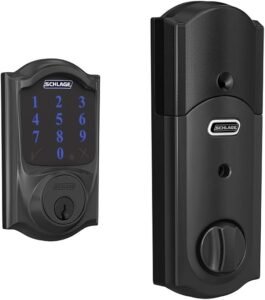Introduction to Smart Locks
Smart locks have transformed the way we secure our homes combining convenience with enhanced safety features. There are a wide variety of smart locks for doors and unlike traditional locks that require physical keys for entry, digital door locks allow you to control your smart home doors through various electronic mechanisms like smartphones, key fobs, or even biometric recognition.

You could also monitor and control your doors remotely, from anywhere with internet access. Whether you are at work, on vacation, or simply away from home, you can ensure your property remains secure. With features such as access logs, notifications, and the ability to grant temporary access to guests or service providers, these devices also contribute significantly to the overall security of a home. Equipped with advanced encryption and anti-tampering technologies, digital door locks provide an extra layer of security that traditional locks often lack. In addition, smart locks can be linked to other smart home technologies, such as smart security cameras, alarms, and even lighting systems, becoming the perfect component to complete your smart home automation system and upgrading your lifestyle.
Key Benefits of Smart Locks
Enhanced Security
- Keyless Entry: Eliminate the risk of lost or stolen keys.
- Advanced Security Features: Employ encryption and biometric authentication for added protection.
- Remote Monitoring: Track who enters and exits your home, and receive real-time alerts.
Convenience
- Remote Access: Control your locks from anywhere in the world.
- Voice Control: Lock and unlock doors with simple voice commands.
- Guest Access: Grant temporary access to visitors or service providers.
Enhanced Security
- Login Tracking: Monitor who enters and exits your home and when.
- Intrusion Detection: Receive alerts if unauthorized attempts are made to access your home.
By incorporating smart locks into your home security system, you can enjoy peace of mind, knowing that your home is protected and your lifestyle is simplified.
Types of Smart Home Locks: A Comprehensive Guide
When it comes to smart home locks, understanding the different types available is key to selecting the perfect solution for your home. Each type offers unique features and benefits, depending on your security needs and your lifestyle preferences. Below you’ll find the three primary categories of smart locks as well as the pros and cons of each one:
Bluetooth Smart Locks
- How They Work: Bluetooth smart locks connect to your smartphone via Bluetooth technology, allowing you to unlock your door with your phone.
- Pros: Energy-efficient, easy to set up, and offers quick and convenient access.
- Cons: Limited range and requires your phone to be nearby.
Wi-Fi Smart Locks
- How They Work: Wi-Fi smart locks connect to your home’s Wi-Fi network, enabling remote control and monitoring.
- Pros: Remote access, customizable features, and integration with other smart home devices.
- Cons: Requires a stable Wi-Fi connection and may be more complex to set up.
Smart Lever Locks
- How They Work: These locks replace traditional lever handles with smart technology, offering keyless entry and remote control.
- Pros: Easy installation, sleek design, and compatibility with various door types.
- Cons: May have limited features compared to dedicated smart locks.
Choosing the Right Smart Lock
When selecting a smart lock, consider factors such as budget, desired features, and compatibility with your existing smart home setup:
- Your Lifestyle: If you frequently travel or need remote access, a Wi-Fi smart lock is ideal. For occasional remote access and energy efficiency, a Bluetooth lock might suffice.
- Security Needs: Assess your security needs, including features like auto-locking, intruder alerts, and access logs.
- Ease of Use: Look for user-friendly apps and intuitive controls.
- Compatibility: Ensure compatibility with your existing smart home system or plans for future integration.
- Design and Style: Choose a lock that complements your home’s aesthetic.
Evaluating the above aspects, you can choose the perfect smart lock to enhance your home’s security and convenience
Top Smart Lock Brands and Product Recommendations
As home security continues to evolve, smart locks have become essential tools for modern living. Several leading brands have emerged, each offering unique features and benefits to cater to diverse consumer needs. Among these, August, Schlage, and Yale stand out for their reliability, innovation, and ease of use.
August Smart Locks: Sleek Design and Smart Integration
August Smart Locks are renowned for their sleek design and seamless integration with existing deadbolts. The August Smart Lock Pro, for instance, offers advanced features like DoorSense technology, which alerts you if your door is left open. Its compatibility with popular smart home ecosystems, including Amazon Alexa and Google Assistant, allows for convenient voice control and automation. While August offers a premium experience, potential buyers should consider their budget, as these locks can be pricier than some alternatives.

Schlage Smart Locks: Robust Security and Wi-Fi Connectivity
Schlage is a trusted name in the smart lock industry, known for its robust security features. The Schlage Encode Smart WiFi Deadbolt is a popular choice, eliminating the need for additional hubs by connecting directly to your home’s Wi-Fi network. This enables remote access, allowing you to monitor and control your lock from anywhere. However, it’s important to ensure compatibility with your door type before purchasing, as some users have reported fitment issues.

Yale Smart Locks: Sleek Design and Versatile Access
Yale smart locks offer a balance of style and functionality. The Yale Assure Lock SL, for example, boasts a sleek, key-free design and supports multiple access methods, including keypad, smartphone, and voice control. While Yale offers competitive pricing, it’s essential to consider battery life, as replacement batteries may be required periodically.

Installation and Setup of Smart Locks
Installing a smart lock is a straightforward process that can be done by anyone. Before you begin, it’s crucial to ensure compatibility with your existing door hardware. Most smart locks are designed to fit standard door sizes, but it’s always a good idea to consult the manufacturer’s specifications to prevent future complications.
Tools You’ll Need
Tools required for the installation typically include a screwdriver (flathead and Phillips), a measuring tape, and possibly a power drill if adjustments to the door or frame are necessary. Some smart locks may include additional components such as a mounting plate or bracket, so referencing the user manual is crucial. If modifications must be made to your door, bear in mind to keep the integrity of the door structure
Installation Steps
To install a smart lock is not rocket science and just involved to carefully remove the existing traditional lock using a screwdriver, follow the manufacturer’s step by step instructions to attach the exterior and interior components of the smart lock to your door ensuring proper alignment of the locking mechanism with the lock plate and connect the device to your Wi-Fi network or to your smartphone Bluetooth depending of the features offered by the chosen smart lock. Almost all of them provide a downloadable app with clear instructions to connect the device to your home’s Wi-Fi network, Bluetooth device or even to configure the biometrics access if supported by the smart lock.
Smart Locks and Home Automation Integration
Smart locks are designed to seamlessly work with various home automation systems such as Amazon Alexa, Google Assistant, and Apple HomeKit, allowing to manage the security with voice commands or mobile applications. This compatibility enables users to create a fully integrated smart home ecosystem where multiple devices work together for optimal efficiency and security.
For instance, when integrated with Amazon Alexa, users can lock or unlock their doors using simple voice commands. This hands-free control is particularly beneficial for individuals carrying groceries or those with mobility challenges. Similarly, integrating smart locks with Google Assistant allows users to receive alerts and manage access to their homes remotely. Homeowners can grant temporary access to guests, service personnel, or family members without being physically present, adding an extra layer of convenience to daily life.
Apple HomeKit offers robust security features that enhance the functionality of smart locks. With a simple command through Siri, users can control their locks alongside other automated devices, such as security cameras and smart lighting. This interconnectedness not only streamlines home management but also strengthens overall home security because users can create customized scenes where multiple devices respond simultaneously during certain events, such as when the homeowner leaves the premises.
Moreover, integration with home automation platforms allows for scheduling access, temporary codes, and alert notifications, further enhancing user control and safety. As smart home technology continues to advance, the compatibility of smart locks with various systems will likely expand, making it easier for consumers to enhance their home security with innovative solutions tailored to their specific needs.
To understand the integration capabilities with other devices, we suggest to read the articles “Smart Home Security” and “Smart Home Lighting” which will give you an idea about other smart home devices and the integration capabilities with them.
Final Thoughts and Choosing the Right Smart Lock for You
As we delve into the realm of smart home locks, it becomes clear that these innovative devices offer a seamless blend of security and convenience. They represent a significant upgrade over traditional locks, incorporating advanced technology that can not only enhance safety but also integrate with broader smart home systems. However, choosing the right smart lock depends on specific needs and circumstances. The diversity of smart locks on the market means there are options ranging from basic keyless models to high-security systems that come with additional features such as alerts and remote monitoring. Scanning through consumer reviews and ratings can also provide insight into the reliability and effectiveness of different brands. Understanding how comfortable you are with technology will help guide your choice. Look for user-friendly interfaces or devices that offer comprehensive tech support if needed. If integrating with other smart devices is a priority, ensure that the lock you select is compatible with your existing setup. In closing, Understanding your security requirements, assessing your comfort with technology, and considering your home automation preferences, you could choose the smart lock that best fits your lifestyle and enhances your home security

